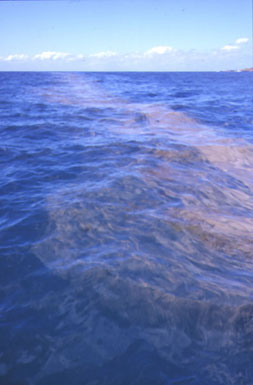Red Tides and Toxins
Red tides are very much in the news these days. Dinoflagellates are usually regarded as the causative organisms, but not all red tides are caused by dinoflagellates and not all dinoflagellates cause red tides. Furthermore, not all red-tide forming algae are toxic. Even the colour factor is variable: so-called 'red tides' may be brown, yellow, green, etc. Some red tides may be very extensive and several square kilometers of ocean may be affected, even to the extent that satellites have been used to track blooms.
 Surface waters of these blooms usually have 1-20 million cells per litre and some are associated with the production of toxins, resulting in fish kills and mortality of other marine organisms.
Surface waters of these blooms usually have 1-20 million cells per litre and some are associated with the production of toxins, resulting in fish kills and mortality of other marine organisms.
Toxic blooms of dinoflagellates fall into three categories: (1) blooms that kill fish but few invertebrates; (2) blooms that kill primarily invertebrates; (3) blooms that kill few marine organisms, but the toxins are concentrated within the siphons, digestive glands, or mantle cavities of filter-feeding bivalve mollusc such as clams, oysters, and escallops, causing paralytic shellfish poisoning (known as PSP). The most notorious PSP-causing dinoflagellate on the Pacific coast of north America is Gonyaulax catenella, which produces a neurotoxin called saxitoxin that is 100,000 times more potent than cocaine.
Saxitoxin acts to prevent normal transmission across neuromuscular synapses by interfering with the movement of sodium ions through excitable membranes. Mussels may become too toxic for human consumption when concentrations of Gonyaulax catenella reach only 100-200 cells per millilitre, but concentrations of 23-30,000 cells per litre will be necessary before a bloom is apparent to the unaided eye. Normally, the toxicity in the mussels disappears within 2-3 weeks after a bloom, but much longer retention times have been found.
What causes such blooms? A range of factors seems to be involved, but very little definite information is available. In some places there appears to be a strong correlation between the occurrence of upwelling (nutrient-rich waters that comes from deep water) and such blooms. But, in other areas, the blooms have been found to be associated with tidal turbulence. Blooms in other areas seem to be set off by heavy rainfall on the land, the runoff washing phosphates into the sea and also lowering the salinity, which factors seem to favour dinoflagellate growth. It is also thought that Vitamin B12, which is required by most dinoflagellates, may also be washed into the sea from the soil and salt-marsh areas, where it is produced by bacteria and blue-green algae. Humic substances have also been suggested as possible causative agents.
Toxic dinoflagellate blooms are recognized to be initiated from benthic resting stages, the cysts occurring in sediments and serving as 'seed populations' when environmental factors cause their resuspension. Such a cycle of encystment is a regular occurrence for many estuarine and neritic species that cause blooms.





